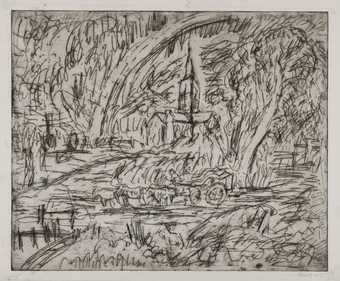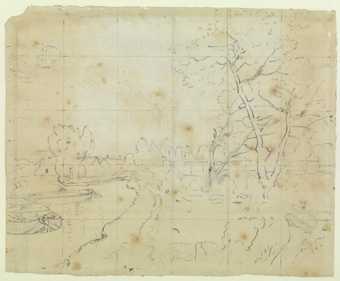This film file is broken and is being removed. Sorry for any inconvenience this causes.
Watch museum curators introduce some of the important themes of the painting and offer personal insights into John Constable’s ideas and approach.
Re-thinking landscape painting
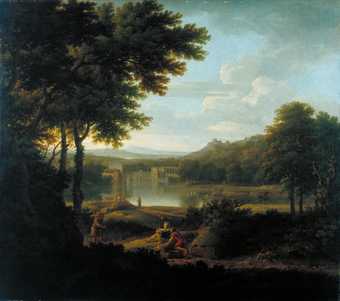
George Lambert
Classical Landscape (1745)
Tate
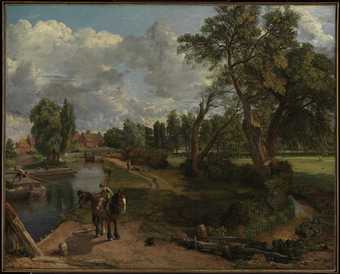
John Constable
Flatford Mill (‘Scene on a Navigable River’) (1816–7)
Tate
the sound of water escaping from mill dams; willows; old rotten planks; slimy posts; and brickwork I love such things…
John Constable
John Constable turned landscape painting on its head. In the early nineteenth century when Constable embarked on his painting career, the dominant tradition was still the classical landscape. This type of painting, popularised in the seventeenth century, did not aim to represent a landscape as it actually looks but instead what it should look like in an ideal world. Features were romanticised and carefully composed using various rules and conventions – every rock, tree and animal painstakingly placed – to create harmonious, but unreal, depictions of landscapes.
Rather than painting idealised views, Constable painted what he saw. He believed that nothing was too mundane or commonplace for his art. In a letter to fellow painter Charles Leslie he said, ‘my limited and abstracted art is to be found under every hedge, and in every lane, and therefore nobody thinks it worth picking up’.
Constable felt that it is the traces of everyday life that make a landscape complete and come alive, and his sketch-books are filled with small details which he later incorporated into his paintings. In Salisbury Cathedral from the Meadows 1831 a horse-drawn wagon is shown crossing the River Nadder, and a sheepdog looks up at the Cathedral.
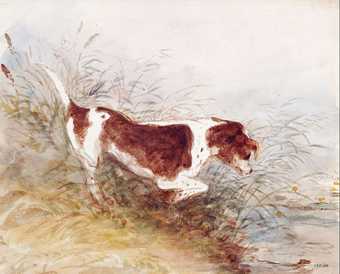
John Constable
A dog watching a rat in the water at Dedham 1831
Pencil and watercolour on paper
© Victoria and Albert Museum, London
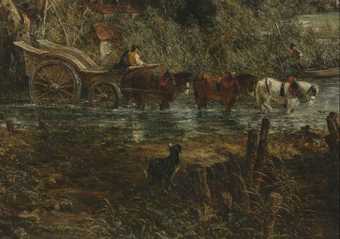
Details from John Constable's Salisbury Cathedral from the Meadows 1831
An emotional landscape

John Constable
Maria Bicknell, Mrs John Constable (1816)
Tate
As well as painting the commonplace, Constable also painted the familiar. He believed that artists should paint landscapes they are personally connected with and which stir their senses and emotions. The first landscapes he painted were of Suffolk where he spent his ‘careless boyhood’ and it was these landscapes he said that ‘made me a painter’.
Like the places of his childhood, Salisbury held a deep personal resonance for Constable. He spent many happy days there in the company of his close friend John Fisher, and had honeymooned there with his wife Maria. But it was also a place of solace. When Maria died at only 40 years old of tuberculosis, he was invited by his friend John Fisher to stay at his home in Salisbury.
When Salisbury Cathedral from the Meadows was first exhibited at the Royal Academy, it was displayed alongside nine lines from a poem by Scottish poet James Thompson. The poem, The Four Seasons: Summer (1727), tells the mythical tale of tragic young lovers Celadon and Amelia. As they walk through a wood during a thunderstorm Amelia is struck by lightening and dies in her lover’s arms. As well as having clear resonances with Constable’s own tragic loss of his wife, the poem had special significance for him. Underpinning its romantic theme the poem has a religious message: it is an exploration of God’s power, and man’s inability to control his own fate.
Composing a sense of place
In order to put across his feelings about a place, Constable often moved or changed elements within the composition. If we compare initial sketches he made from the meadows of Salisbury Cathedral, to the finished painting; we can see that he has changed various things to create a final composition that emphasises what Salisbury meant to him.
The Church of St Thomas, seen on the left of the painting is not visible from this spot in real life – as the view in the sketch shows. Perhaps the addition of the church tower was an attempt by Constable to strengthen the visible presence and importance of the Anglican Church. Also, at the base of the tall ash tree that dominates the work, Constable has added an elder bush, (recognisable by its white blossom). Constable once wrote of the elder bush ‘it is a favourite of mine, but ‘tis melancholy; an emblem of death’. This addition perhaps relates to the recent death of his wife. By contrast the ash tree is often seen as symbol of resurrection, or life after death.

John Constable
Salisbury Cathedral from the Meadows (?1829)
Tate
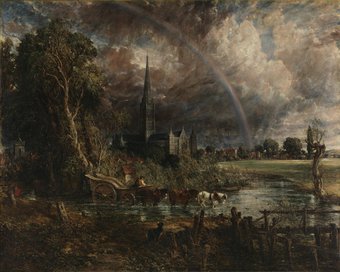
John Constable
Salisbury Cathedral from the Meadows (exhibited 1831)
Tate
Weather-watching
The skies in many of Constable’s landscapes set the mood or emotional tone for the painting. In 1821 Constable wrote to his friend John Fisher:
The landscape painter who does not make his skies a very material part of his composition neglects to avail himself of one of his greatest aids. It will be difficult to name a class of landscape in which the sky is not the ‘key note’, the ‘standard of scale’ and the chief ‘organ of sentiment’.
Constable began to make studies of skies in 1819, while he was living in Hampstead in London. These sketches were made outside and show a remarkable understanding of the structure and movement of clouds. Many are inscribed with details of the date, time and the weather conditions. In 1821 he told John Fisher: ‘I have done a good deal of skying…I am determined to conquer all difficulties, and that most arduous one among the rest’
Watch Gavin Pretor-Pinney of the Cloud Appreciation Society and author of The Cloudspotter’s Guide apply his spotter’s eye to Tate’s Collection, beginning with Constable’s cloud depictions:
The weather as symbol
The first thing you notice if you look at Salisbury Cathedral from the Meadows 1831 is its sky. Brooding storm-clouds and a streak of lightning are set dramatically against a rainbow and a small glimmer of sunlight. If the painting is again compared to the small study made for the finished work, the dramatic nature of the sky becomes more loaded. In the smaller sketch there appears to be a storm gathering just beyond the cathedral, but this is almost absorbed into the loose, expressive, handling of the paint. In the finished picture, however we are instantly hit by the full impact of a raging storm.
Unlike the weather studies depicted from life, the sky in the final work with its combination of different weather components, is actually an impossibility. We know that Constable had an understanding of meteorology, so we can assume that these weather extremes are important to reading the painting. He was using the weather to express the range of emotions he was feeling at that time. One of the additions not in the original sketch is the rainbow. This was added late to the painting. It seems to offer hope that life’s storms can be weathered. Tellingly, the rainbow appears to rest on Leadenhall – the home of John Fisher who died just four days after the painting was exhibited – and becomes a tribute to their freindship.
Politics, rural life and religion
As well as reflecting events in his personal life and their emotional impact, the painting also seems to reflect Constable’s political and religious views.
Various political, social and economic changes were taking place around the time Constable was working on the painting. These threatened the future of two things that were important to Constable: the Anglican Church (which had provided comfort to the artist during his recent personal troubles); and rural life – which endlessly inspired him.
Politics
Constable’s politics were Tory, conventional, and generally unsympathetic to anything beyond the status quo.
Conditioned by his background as the son of a prosperous self-made miller, merchant and rural employer, as well as by his own social and professional aspirations as an artist in London, his political views were untouched by urban radicalism. It might seem paradoxical that an artist so radical in his reinvention of landscape painting could be so socially conservative: but his insistence on celebrating the everyday details of the countryside, can perhaps be seen as an attempt to hold on to something threatened by change.
In 1831 there was talk of electoral reform. Under the existing system, rapidly growing industrial towns such as Manchester and Birmingham had no MPs representing them at all. At the same time, there were boroughs that had more than one MP and hardly any voters! Although in reality, the Reform Act which was passed in 1832 had little effect on the plight of the urban working classes, Constable saw it as a ‘tremendous attack on the Constitution of the country’. The alarm he felt was probably partly due to the influence of his friends the Fishers, who were worried that reform would reduce the power of the Church. Constable’s images of Sarum on the outskirts of Salisbury, and one of the so called ‘rotten boroughs’ ripe for reform, show it in stormy ‘desolation’ suggesting his worries about political changes and the prospect of an uncertain future.
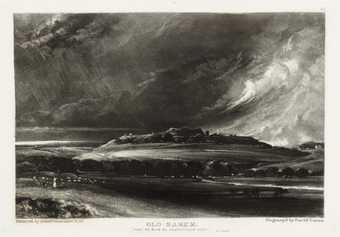
John Constable, David Lucas
Old Sarum (second plate) (published 1855)
Tate
Urban vs rural
Another aspect of Constable’s life that seemed under threat from parliamentary legislation, was his beloved countryside. The Enclosure Acts of 1773 and 1801 massively impacted on rural life in Britain.
These acts enabled landowners to fence off land and remove the right of commoners to access to it. The acts also allowed landowners to charge higher rents to people working the land. Constable’s brother wrote to him of ‘fires’ and disorder in East Anglia as poorly-paid workers revolted against job cuts and rising food prices. This happened against the backdrop of the industrial revolution which saw a huge growth in large-scale manufacturing at the expense of smaller cottage industries. The result of these changes was that there was an exodus of people from rural areas as they moved to big industrial cities to find work. The countryside became depopulated and traditional rural life seemed in danger of becoming a lost Eden, contrasting sharply with a future of modern urban life and its perceived evils. In this light the simple details captured by Constable, such as hay wains and dappled meadows, become precious expressions of the importance of rural life and an attempt to hold onto it.
Religion
There was also much debate about the place and the power of the church in British politics around the time Constable began to think about painting his ‘great Salisbury’. A supporter of the traditional partnership of Church and State, Constable was a conventional Anglican.
In 1829 the Catholic Emancipation Act was passed allowing Catholics to sit in Parliament. Although this might seem like perfectly reasonable legislation, not everyone at that time agreed. Traditionalists including Constable and Archdeacon Fisher, saw it as an assault on the fabric of the British establishment – Fisher described it as a great ‘mischief’, and Constable referred to reform campaigners as ‘vultures’. This caricature by William Heath from 1829 reflects the fear that they and other traditionalists felt. The steeple of a church is being pulled down by the Prime Minister, Lord Wellington, and others. On the left-hand side a monk is shown trailing gunpowder – suggesting the perceived threat to the Anglican Church and the political establishment.
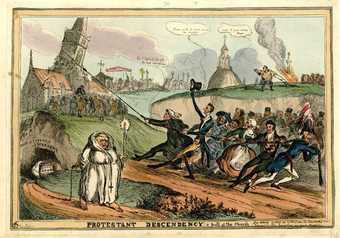
William Heath
Protestant descendency, a pull at the Church 1829
Hand coloured etching
© The Trustees of the British Museum
How are these concerns reflected in the painting?
In Salisbury Cathedral from the Meadows 1831 the church is literally shown under a cloud – seeming to reflect Constable’s concerns that the recent parliamentary reform might reduce the power of the Church, and by extension the livlihood of his best friend.
But it’s not all doom and gloom. Religion also has a more positive presence in the painting. The Fishers encouraged Constable’s view of nature as reflecting divine providence. Alongside the storm, which seems to mirror Constable’s personal sadness and general worries, the rainbow and glimmers of sunshine, promise the storm’s passing and suggest the gradual lifting of despair through the comfort of a more enduring faith.
Tate curator Amy Concannon has suggested that the view of the cathedral Constable chose to capture – showing the cathedral and the city surrounding it, but seen from a countryside setting across meadows – is significant:
In Salisbury Cathedral from the Meadows the religious building physically connects city and countryside, emphasising the power Constable saw in it as a factor for uniting society and promoting good morals. Constable shows it weathering the storm, the rainbow offering hope, perhaps of a peaceful future.



